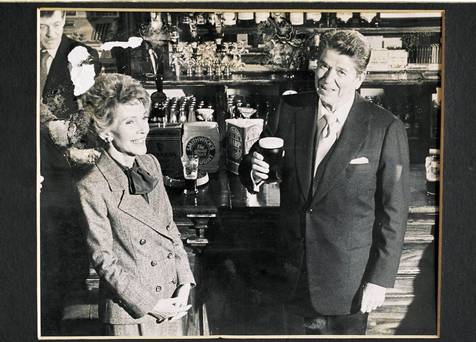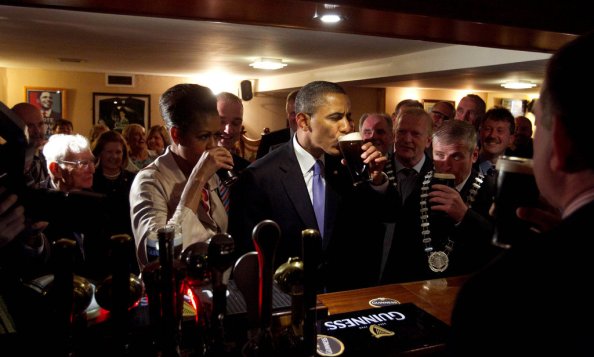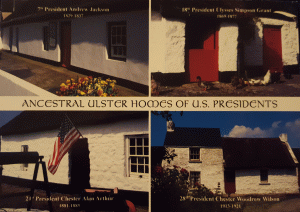A few weeks ago I looked at the tours of Ireland by Ulysses S. Grant, John F. Kennedy, and Richard Nixon. You can find that post here.
Now let’s take a look at the visits from American presidents since the 1980s.
RONALD REAGAN

Ronald and Nancy Reagan in Ballyporeen – photo credit: Independent.ie
Earlier this year, RTE’s History Show did a podcast on Reagan’s visit to Ireland, which you can find here. It highlights the mixed reception he was subjected to throughout his visit, given American policies in Central and South America at the time.
Reagan arrived at Shannon for a four-day visit on 1 June 1984. He received an honorary degree, which caused quite a bit of controversy, at NUI Galway
On 3 June, Reagan visited his great-grandfather’s hometown of Ballyporeen in Tipperary. Before his visit, he had little knowledge of his family roots because his father had been orphaned at a young age, so there was not much of a sense of connection to the family’s past.
It’s difficult to express my appreciation to all of you. I feel like I’m about to drown everyone in a bath of nostalgia.
-Ronald Reagan at Ballyporeen
He stopped in at Ballyporeen’s Ronald Reagan Lounge, the facade and fittings of which were later moved to the Reagan Presidential Library in California.
From there, Reagan went to Dublin, where he stayed at the US Embassy in Phoenix Park and addressed a joint session of the Irish National Parliament, highlighted by his celebration of the connection between the US and Ireland, as well as addressing IRA attacks in Northern Ireland and London.
Reagan’s remarks at Ballyporeen
Address before a Joint Session of the Irish National Parliament
BILL CLINTON
Bill Clinton arrived in Northern Ireland at a key moment in 1995. His decision to previous year to grant a visa to Sinn Fein leader Gerry Adams had garnered both praise and high levels of criticism. He became the first sitting US President to visit Northern Ireland, arriving in Belfast on 30 November. He was self-consciously leading the US to intervene in British-Northern Ireland relations, calling for reconciliation to end the Troubles.
Over the last 3 years since I have had the privilege to be the President of the United States I have had occasion to meet with Nationalists and to meet with Unionists and to listen to their sides of the story. I have come to the conclusion that here, as in so many other places in the world, from the Middle East to Bosnia, the divisions that are most important here are not the divisions between opposing views or opposing interests. Those divisions can be reconciled. The deep divisions, the most important ones, are those between the peacemakers and the enemies of peace: those who, deep, deep down inside, want peace more than anything and those who, deep down inside, can’t bring themselves to reach out for peace; those who are in the ship of peace and those who would sink it; those who bravely meet on the bridge of reconciliation and those who would blow it up.
-Bill Clinton in Derry
Clinton’s visit was considered extremely successful, leading the United States to play an undeniably key role in the peace process. With George Mitchell as lead negotiator, the Good Friday agreement was agreed in 1998.
Clinton made two further presidential trips to Ireland. In September 1998 his trip included a visit to Omagh, shortly after the bombing there. And he returned in December 2000, including a visit to Dublin and Drumconda.
GEORGE W. BUSH
https://www.c-span.org/video/standalone/?182453-1/presidential-interview-irish-television
George W. Bush’s visit to Ireland was marked by controversy before it started. He conducted an exclusive RTE interview (seen above) with Carole Coleman from the White House the day before his visit, causing tensions with tough questions on the Iraq War, conduct of American soldiers, terrorism, and weapons of mass destruction. RTE had planned another interview with Laura Bush, but this was cancelled.
Bush arrived at Shannon on 25 June 2004, staying at Dromoland Castle in County Clare and attending a two-day European Union-US summit. He also met with Bernie Ahern and Mary McAleese.
His visit was marked by the need for high levels of security, and protests against the Iraq War and American military actions.
BARACK OBAMA
The most recent Presidential trip to Ireland was that of Barack Obama in 2011. He arrived in Dublin with the First Lady on the morning of 23 May, meeting with Mary McAleese and Enda Kenny.
Next, he traveled to his ancestral hometown of Moneygall, County Offaly, shaking hands with as many as possible who came out to greet him in the rain.

The Obamas in Moneygall – photo credit: New York Times
After enjoying a pint of Guinness, the Obamas headed back to Dublin. President Obama gave a speech in College Green before departing for London amidst the Iceland volcanic ash cloud.
Now, of course, an American doesn’t really require Irish blood to understand that ours is a proud, enduring, centuries-old relationship; that we are bound by history and friendship and shared values. And that’s why I’ve come here today, as an American President, to reaffirm those bonds of affection.
-Barack Obama in Dublin
White House image gallery of President Obama’s visit
New York Times coverage of the trip
Is féidir linn

